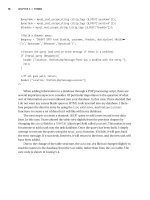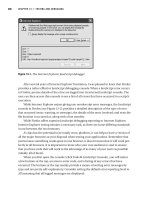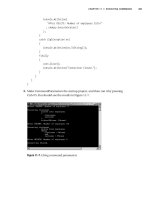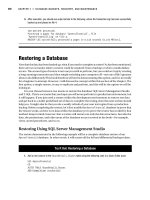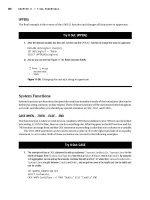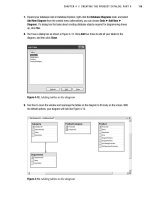Beginning Java SE 6 Platform From Novice to Professional phần 10 docx
Bạn đang xem bản rút gọn của tài liệu. Xem và tải ngay bản đầy đủ của tài liệu tại đây (444.06 KB, 51 trang )
System.out.println (sqlex);
}
}
}
Java DB version 10.2.1.7 does not support the SQL XML data type.
8. The purpose of
dblook’s -z option is to limit DDL generation to a specific schema;
only those database objects that belong to the schema will have their DDL state-
ments generated. The purpose of
dblook’s -t option is to limit table-related DDL
generation to those tables identified by this option. The purpose of
dblook’s -td
option is to specify the DDL statement terminator (which is the semicolon charac-
ter by default).
9. Listing D-10 presents a
DumpSchemas application that takes a single command-line
argument, the JDBC URL to a data source, and dumps the names of its schemas to
the standard output.
Listing D-10. DumpSchemas.java
// DumpSchemas.java
import java.sql.*;
public class DumpSchemas
{
public static void main (String [] args)
{
if (args.length != 1)
{
System.err.println ("usage: java DumpSchemas jdbcURL");
return;
}
try
{
Connection con;
con = DriverManager.getConnection (args [0]);
APPENDIX D ■ TEST YOUR UNDERSTANDING ANSWERS436
830-X XD.qxd 9/24/07 8:25 PM Page 436
DatabaseMetaData dbmd = con.getMetaData ();
ResultSet rs = dbmd.getSchemas ();
while (rs.next ())
System.out.println (rs.getString (1));
if (con.getMetaData ().getDriverName ().equals ("Apache Derby "+
"Embedded JDBC Driver"))
try
{
DriverManager.getConnection ("jdbc:derby:;shutdown=true");
}
catch (SQLException sqlex)
{
System.out.println ("Database shut down normally");
}
}
catch (SQLException sqlex)
{
System.out.println (sqlex);
}
}
}
When you run this application against the EMPLOYEE database, the following
schemas are identified:
APP
NULLID
SQLJ
SYS
SYSCAT
SYSCS_DIAG
SYSCS_UTIL
SYSFUN
SYSIBM
SYSPROC
SYSSTAT
APPENDIX D ■ TEST YOUR UNDERSTANDING ANSWERS 437
830-X XD.qxd 9/24/07 8:25 PM Page 437
Chapter 7: Monitoring and Management
1. Local monitoring refers to running JConsole (or any JMX client) on the same
machine as the application being monitored. Both the application and JConsole
must belong to the same user. You do not need to specify the
com.sun.management.
jmxremote system property when starting an application to be locally monitored
under Java SE 6.
2. According to the JDK documentation for
Class’s protected final Class<?>
defineClass(String name, byte[] b, int off, int len) method, class definition
involves converting an array of bytes into an instance of class
Class. In contrast,
transformation involves changing the definition in some way, such as instrument-
ing the class through the addition of bytecodes to various methods. Redefinition
does not cause a class’s initializers to run. The
retransform() method identifies
these steps for retransformation:
• Begin with the initial class-file bytes.
• For each transformer added via
void addTransformer(ClassFileTransformer
transformer), or void addTransformer(ClassFileTransformer transformer,
boolean canRetransform) where false is passed to canRetransform, the bytes
returned by the
transform() method during the last class load or redefinition
are reused as the output of the transformation.
• For each transformer that was added with
true passed to canRetransform, the
transform() method is called in these transformers.
• The transformed class-file bytes are installed as the new definition of the class.
3. The
agentmain() method is often (but not necessarily) invoked after an applica-
tion’s
main() method has run. In contrast, premain() is always invoked before
main() runs. Also, agentmain() is invoked as a result of dynamic attach, whereas
premain() is invoked as a result of starting the virtual machine with the -javaagent
option, which specifies an agent JAR file’s path and name.
4. Listing D-11 presents a
LoadAverageViewer application that invokes
OperatingSystemMXBean’s getSystemLoadAverage() method. If this method returns a
negative value, the application outputs a message stating that the load average is
not supported on this platform. Otherwise, it repeatedly outputs the load average
once per minute, for a specific number of minutes as determined by a command-
line argument.
APPENDIX D ■ TEST YOUR UNDERSTANDING ANSWERS438
830-X XD.qxd 9/24/07 8:25 PM Page 438
Listing D-11. LoadAverageViewer.java
// LoadAverageViewer.java;
// Unix compile : javac -cp $JAVA_HOME/lib/tools.jar LoadAverageViewer.java
//
// Windows compile: javac -cp %JAVA_HOME%/lib/tools.jar LoadAverageViewer.java
import static java.lang.management.ManagementFactory.*;
import java.lang.management.*;
import java.io.*;
import java.util.*;
import javax.management.*;
import javax.management.remote.*;
import com.sun.tools.attach.*;
public class LoadAverageViewer
{
static final String CON_ADDR =
"com.sun.management.jmxremote.localConnectorAddress";
static final int MIN_MINUTES = 2;
static final int MAX_MINUTES = 10;
public static void main (String [] args) throws Exception
{
int minutes = MIN_MINUTES;
if (args.length != 2)
{
System.err.println ("Unix usage : "+
"java -cp $JAVA_HOME/lib/tools.jar:. "+
"LoadAverageViewer pid minutes");
System.err.println ();
System.err.println ("Windows usage: "+
"java -cp %JAVA_HOME%/lib/tools.jar;. "+
"LoadAverageViewer pid minutes");
APPENDIX D ■ TEST YOUR UNDERSTANDING ANSWERS 439
830-X XD.qxd 9/24/07 8:25 PM Page 439
return;
}
try
{
int min = Integer.parseInt (args [1]);
if (min < MIN_MINUTES || min > MAX_MINUTES)
{
System.err.println (min+" out of range ["+MIN_MINUTES+", "+
MAX_MINUTES+"]");
return;
}
minutes = min;
}
catch (NumberFormatException nfe)
{
System.err.println ("Unable to parse "+args [1]+" as an integer.");
System.err.println ("LoadAverageViewer will repeatedly check "+
" average (if available) every minute for "+
MIN_MINUTES+" minutes.");
}
// Attempt to attach to the target virtual machine whose identifier is
// specified as a command-line argument.
VirtualMachine vm = VirtualMachine.attach (args [0]);
// Attempt to obtain the target virtual machine's connector address so
// that this virtual machine can communicate with its connector server.
String conAddr = vm.getAgentProperties ().getProperty (CON_ADDR);
// If there is no connector address, a connector server and JMX agent
// are not started in the target virtual machine. Therefore, load the
// JMX agent into the target.
if (conAddr == null)
{
// The JMX agent is stored in management-agent.jar. This JAR file
// is located in the lib subdirectory of the JRE's home directory.
String agent = vm.getSystemProperties ()
APPENDIX D ■ TEST YOUR UNDERSTANDING ANSWERS440
830-X XD.qxd 9/24/07 8:25 PM Page 440
.getProperty ("java.home")+File.separator+
"lib"+File.separator+"management-agent.jar";
// Attempt to load the JMX agent.
vm.loadAgent (agent);
// Once again, attempt to obtain the target virtual machine's
// connector address.
conAddr = vm.getAgentProperties ().getProperty (CON_ADDR);
// Although the second attempt to obtain the connector address
// should succeed, throw an exception if it does not.
if (conAddr == null)
throw new NullPointerException ("conAddr is null");
}
// Prior to connecting to the target virtual machine's connector
// server, the String-based connector address must be converted into a
// JMXServiceURL.
JMXServiceURL servURL = new JMXServiceURL (conAddr);
// Attempt to create a connector client that is connected to the
// connector server located at the specified URL.
JMXConnector con = JMXConnectorFactory.connect (servURL);
// Attempt to obtain an MBeanServerConnection that represents the
// remote JMX agent's MBean server.
MBeanServerConnection mbsc = con.getMBeanServerConnection ();
// Obtain object name for thread MBean, and use this name to obtain the
// name of the OS MBean that is controlled by the JMX agent's MBean
// server.
ObjectName osName = new ObjectName (OPERATING_SYSTEM_MXBEAN_NAME);
Set<ObjectName> mbeans = mbsc.queryNames (osName, null);
APPENDIX D ■ TEST YOUR UNDERSTANDING ANSWERS 441
830-X XD.qxd 9/24/07 8:25 PM Page 441
// The for-each loop conveniently returns the name of the OS MBean.
// There should only be one iteration because there is only one OS
// MBean.
for (ObjectName name: mbeans)
{
// Obtain a proxy for the OperatingSystemMXBean interface that
// forwards its method calls through the MBeanServerConnection
// identified by mbsc.
OperatingSystemMXBean osb;
osb = newPlatformMXBeanProxy (mbsc, name.toString (),
OperatingSystemMXBean.class);
double loadAverage = osb.getSystemLoadAverage ();
if (loadAverage < 0)
{ System.out.println (loadAverage);
System.out.println ("Load average not supported on platform");
return;
}
for (int i = 0; i < minutes; i++)
{
System.out.printf ("Load average: %f", loadAverage);
System.out.println ();
try
{
Thread.sleep (60000); // Sleep for about one minute.
}
catch (InterruptedException ie)
{
}
loadAverage = osb.getSystemLoadAverage ();
}
break;
}
}
}
APPENDIX D ■ TEST YOUR UNDERSTANDING ANSWERS442
830-X XD.qxd 9/24/07 8:25 PM Page 442
5. The purpose of the JConsole API’s JConsoleContext interface is to represent a
JConsole connection to an application running in a target virtual machine.
6. The
java.beans.PropertyChangeListener is added to a plug-in’s JConsoleContext
via JConsolePlugin’s public final void addContextPropertyChangeListener
(PropertyChangeListener listener) method, or via a call to JConsolePlugin’s public
final JConsoleContext getContext() method followed by a call to JConsoleContext’s
void addPropertyChangeListener(PropertyChangeListener listener) method
(assuming that
getContext() does not return null). It is invoked when the
connection state between JConsole and a target virtual machine changes.
The
JConsoleContext.ConnectionState enumeration’s CONNECTED, CONNECTING, and
DISCONNECTED constants identify the three connection states.
This listener benefits a plug-in by providing a convenient place to obtain a new
javax.management.MBeanServerConnection via JConsoleContext’s
MBeanServerConnection getMBeanServerConnection() method when the connection
state becomes
CONNECTED. The current MBeanServerConnection becomes invalid
when the connection is disconnected. The sample JTop plug-in’s
jtopplugin.
java source code (included in the JDK) shows how to implement
PropertyChangeListener’s void propertyChange(PropertyChangeEvent evt)
method to restore the MBeanServerConnection.
Chapter 8: Networking
1. If you placed new URL (args [0]).openConnection ().getContent (); before
CookieManager cm = new CookieManager (); in Listing 8-1, you would observe no
cookie output. The HTTP protocol handler requires an implementation (the
cookie manager, for example) of a system-wide cookie handler to be present
before it executes. This is because the protocol handler invokes the system-
wide cookie handler’s
public void put(URI uri, Map<String,List<String>>
responseHeaders) method to store response cookies in a cookie cache. It cannot
invoke this method to accomplish this task if a cookie handler implementation
has not been installed.
2.
IDN’s toASCII() methods throw IllegalArgumentException if their input strings do
not conform to RFC 3490.
APPENDIX D ■ TEST YOUR UNDERSTANDING ANSWERS 443
830-X XD.qxd 9/24/07 8:25 PM Page 443
3. The following excerpt from the revised MinimalHTTPServer application (see Listing 8-4
for the original application’s source code) introduces a
DateHandler class associ-
ated with the
/date root URI. In addition to this excerpt, you need to add a
server.createContext ("/date", new DateHandler ()); method call in the main()
method.
class DateHandler implements HttpHandler
{
public void handle (HttpExchange xchg) throws IOException
{
xchg.sendResponseHeaders (200, 0);
OutputStream os = xchg.getResponseBody ();
DataOutputStream dos = new DataOutputStream (os);
dos.writeBytes ("<html><head></head><body><center><b>"+
new Date ().toString ()+"</b></center></body></html>");
dos.close ();
}
}
4. The following excerpt from the revised NetParms application (see Listing 8-5 for the
original application’s source code) obtains all accessible
InterfaceAddresses for
each network interface, and outputs each
InterfaceAddress’s IP address, broadcast
address, and network prefix length/subnet mask:
List<InterfaceAddress> ias = ni.getInterfaceAddresses ();
for (InterfaceAddress ia: ias)
{
// Because it is possible for getInterfaceAddresses() to
// return a list consisting of a single null element I
// found this to be the case for a WAN (PPP/SLIP) interface
// an if statement test is needed to prevent a
// NullPointerException.
if (ia == null)
break;
System.out.println ("Interface Address");
System.out.println (" Address: "+ia.getAddress ());
System.out.println (" Broadcast: "+ia.getBroadcast ());
System.out.println (" Prefix length/Subnet mask: "+
ia.getNetworkPrefixLength ());
}
APPENDIX D ■ TEST YOUR UNDERSTANDING ANSWERS444
830-X XD.qxd 9/24/07 8:25 PM Page 444
Chapter 9: Scripting
1. The name of the package assigned to the Scripting API is javax.script.
2. The
Compilable interface describes a script engine that lets scripts be compiled to
intermediate code. The
CompiledScript abstract class is extended by subclasses
that store the results of compilations—the intermediate code, as it were.
3. The scripting language associated with Java SE 6’s Rhino-based script engine is
JavaScript.
4.
ScriptEngineFactory’s getEngineName() method returns an engine’s full name (such
as
Mozilla Rhino). ScriptEngineFactory’s getNames() method returns a list of engine
short names (such as
rhino). You can pass any short name to ScriptEngineManager’s
getEngineByName(String shortName) method.
5. For a script engine to exhibit the
MULTITHREADED threading behavior, scripts can
execute concurrently on different threads, although the effects of executing a
script on one thread might be visible to threads executing on other threads.
6.
ScriptEngineManager’s getEngineByExtension(String extension) method would be
appropriate for obtaining a script engine after selecting the name of a script file
via a dialog box.
7.
ScriptEngine offers six eval() methods for evaluating scripts.
8. The Rhino-based script engine does not import the
java.lang package by default
to prevent conflicts with same-named JavaScript types—
Object, Math, Boolean, and
so on.
9. The problem with
importPackage() and importClass() is that they pollute
JavaScript’s global variable scope. Rhino overcomes this problem by providing a
JavaImporter class that works with JavaScript’s with statement to let you specify
classes and interfaces without their package names from within this statement’s
scope.
10. A Java program communicates with a script by passing objects to the script via
script variables, and by obtaining script variable values as objects.
ScriptEngine
provides void put(String key, Object value) and Object get(String key) methods
for these tasks.
APPENDIX D ■ TEST YOUR UNDERSTANDING ANSWERS 445
830-X XD.qxd 9/24/07 8:25 PM Page 445
11. jrunscript makes command-line arguments available to a script by invoking
engine.put("arguments", args) followed by engine.put(ScriptEngine.ARGV, args),
where
args is the name of the String array passed to this tool’s entry-point
method.
12. A bindings object is a map that stores key/value pairs, where keys are expressed as
Strings.
13. With engine scope, a bindings object is visible to a specific script engine through-
out the engine’s lifetime; other script engines do not have access to this bindings
object (unless you share it with them). With global scope, a bindings object is visi-
ble to all script engines that are created with the same script engine manager.
14.
ScriptEngine provides a setBindings(Bindings bindings, int scope) method that
allows the global bindings to be replaced so that
ScriptEngineManager’s
getEngineByExtension(), getEngineByMimeType(), and getEngineByName() methods
can share the global scope’s bindings object with a newly created script engine.
15. A script context connects a script engine to a Java program. It exposes the global
and engine bindings objects. It also exposes a reader and a pair of writers that a
script engine uses for input and output.
16.
eval(String script, ScriptContext context) evaluates a script with an explicitly
specified script context.
eval(String script, Bindings n) creates a new temporary
script context (with engine bindings set to
n, and with global bindings set to the
default context’s global bindings) before evaluating a script.
17. The purpose of the
context script variable is to describe a SimpleScriptContext
object that lets a script engine access the script context. You would output this
variable’s value in Rhino-based JavaScript via
println (context). You would output
this variable’s value in JRuby via
puts $context.
18. Anything passed to the
getOutputStatement() method’s toDisplay String argument
is quoted in the output statement returned by this method. This means that you
cannot use
getOutputStatement() to generate a statement for outputting a vari-
able’s value, unless you subsequently replace the quotation marks with spaces
(as described in Chapter 9).
19. You compile a script by first making sure that its script engine instance imple-
ments the
Compilable interface. Next, cast the script engine instance to a
Compilable instance. Finally, invoke one of Compilable’s compile() methods on
this instance.
APPENDIX D ■ TEST YOUR UNDERSTANDING ANSWERS446
830-X XD.qxd 9/24/07 8:25 PM Page 446
20. One benefit provided by the Invocable interface is performance. The
invokeFunction() and invokeMethod() methods execute intermediate code. Unlike
the
eval() methods, they do not need to first parse a script into intermediate code,
which can be time consuming. Another benefit of the
Invocable interface is mini-
mal coupling. The
getInterface() methods return Java interface objects, whose
methods are implemented by a script’s global or object member functions. These
objects minimize a Java program’s exposure to the script.
21.
jrunscript is an experimental command-line, script-shell tool for exploring
scripting languages and their communication with Java.
22. You would discover the implementations for the
jlist(), jmap(), and JSInvoker()
functions by invoking println (jlist), println (jmap), and println (JSInvoker).
23.
JSAdapter is a java.lang.reflect.Proxy equivalent for JavaScript. JSAdapter lets you
adapt property access (as in
x.i), mutator (as in x.p = 10), and other simple
JavaScript syntax on a proxy object to a delegate JavaScript object’s member func-
tions.
24. If you were to modify
demo.html’s setColor(color) function to print document.
linkcolor’s value before and after setting this property to the color argument
(as in
function setColor(color) { println ("Before = "+document.linkcolor);
document.linkcolor = color; println ("After = "+document.linkcolor); }), you
would notice that the first time you move the mouse pointer over either of this
document’s two links,
Before = java.awt.Color[r=0,g=0,b=0] outputs. This output
indicates that
document.linkcolor’s initial value is black (instead of blue, assuming
the default setting). The reason is that a link’s text derives its foreground color
(blue by default) from the document’s style sheet, not from its foreground color
attribute, which happens to be black.
To fix this to output
Before = java.awt.Color[r=0,g=0,b=255] (again, assuming the
default blue style sheet setting) instead, you would make the following changes to
the
ScriptEnvironment class:
• Add a
private boolean first = true; field.
• Modify
getLinkColor() to the following:
public Color getLinkColor ()
{
if (first)
{
setLinksDefaultColorToCSS ();
first = false;
APPENDIX D ■ TEST YOUR UNDERSTANDING ANSWERS 447
830-X XD.qxd 9/24/07 8:25 PM Page 447
}
AttributeSet as = currentAnchor.getAttributes ();
return StyleConstants.getForeground (as);
}
• Add the following setLinksDefaultColorToCSS() method:
public void setLinksDefaultColorToCSS ()
{
HTMLDocument doc;
doc = (HTMLDocument) ScriptedEditorPane.this.getDocument ();
StyleContext sc = StyleContext.getDefaultStyleContext ();
AttributeSet as = sc.addAttribute (SimpleAttributeSet.EMPTY,
StyleConstants.Foreground,
defaultLinkColor);
HTMLDocument.Iterator itr = doc.getIterator (HTML.Tag.A);
while (itr.isValid ())
{
doc.setCharacterAttributes (itr.getStartOffset (),
itr.getEndOffset ()-
itr.getStartOffset (), as, false);
itr.next ();
}
}
25. Listing D-12 presents a WorkingWithJRuby application that invokes
WorkingWithJavaFXScript.
Listing D-12. WorkingWithJRuby.java
// WorkingWithJRuby.java
import javax.script.*;
public class WorkingWithJRuby
{
public static void main (String [] args) throws Exception
{
ScriptEngineManager manager = new ScriptEngineManager ();
APPENDIX D ■ TEST YOUR UNDERSTANDING ANSWERS448
830-X XD.qxd 9/24/07 8:25 PM Page 448
// The JRuby script engine is accessed via the jruby short name.
ScriptEngine engine = manager.getEngineByName ("jruby");
engine.eval ("`java WorkingWithJavaFXScript`");
}
}
Ruby invokes an external program by placing the command line between a pair
of backtick (
`) characters. In order for WorkingWithJavaFXScript to run properly,
Filters.jar, javafxrt.jar, and swing-layout.jar must be part of the classpath.
Chapter 10: Security and Web Services
1. A Java application communicates with applications running on a smart card by
exchanging ISO/IEC 7816-4 APDUs.
2. The package assigned to the Smart Card I/O API is
javax.smartcardio.
3. A terminal is a card reader slot in which to insert a smart card.
4. Authenticity means that you can determine who sent the data. Integrity means
that the data has not been modified in transit. Nonrepudiation means that
senders cannot deny sending their documents.
5. A digital signature is an encrypted hash or message digest.
6. Assuming public-key cryptography, digitally signing a document requires the
sender to use the sender’s private key to sign the document (which results in an
encrypted hash), and the recipient to use the sender’s public key to decrypt the
encrypted hash. In contrast, encrypting a document requires the sender to per-
form the encryption via the recipient’s public key, and the recipient to perform
the decryption via the recipient’s private key.
7. An XML Signature is a
Signature element and its contained elements, where
the signature is calculated over the
SignedInfo section and stored in the
SignatureValue element.
8. Canonicalization converts XML content to a standardized physical representation,
to eliminate subtle changes that can invalidate a signature over the XML content.
APPENDIX D ■ TEST YOUR UNDERSTANDING ANSWERS 449
830-X XD.qxd 9/24/07 8:25 PM Page 449
9. Base64 is the algorithm used to encode the SignatureValue element’s signature in
an XML document.
10. The
Signature element is excluded from the data object’s signature value calcula-
tion for the enveloped XML Signature type.
11. The
XMLSignatureFactory class is the entry point into the XML Digital Signature
APIs.
12. An application obtains an instance of the XML Digital Signature APIs entry-point
class by invoking one of
XMLSignatureFactory’s getInstance() methods.
13. The web services stack’s layered architecture is composed of the JAX-WS, JAXB,
and StAX APIs. The stack also benefits from the SAAJ and Web Services Metadata
APIs.
14.
@WebService is used to annotate a web service class.
15. A web service is published by invoking the
javax.xml.ws.EndPoint class’s public
static Endpoint publish(String address, Object implementor) method with the
web service’s address URI and an instance of the web service class as arguments.
16. The tool used to generate web service artifacts needed to deploy a web service is
wsgen.
17. The tool used to generate web service artifacts needed to import a web service to
client programs is
wsimport.
18. Listing D-13 presents a revised
SkyView application (shown in Listing 10-8) whose
use of
SwingWorker<T, V> ensures that the GUI is still responsive whenever byte []
image = Imgcutoutsoap.getJpeg (ra, dec, scale, IMAGE_WIDTH, IMAGE_HEIGHT,
dopt); takes a while to complete. (Differences between Listing D-13 and
Listing 10-8 are highlighted.)
Listing D-13. SkyView.java
// SkyView.java
import java.awt.*;
import java.awt.event.*;
import java.awt.image.*;
import java.io.*;
APPENDIX D ■ TEST YOUR UNDERSTANDING ANSWERS450
830-X XD.qxd 9/24/07 8:25 PM Page 450
import javax.imageio.*;
import javax.swing.*;
import org.sdss.skyserver.*;
public class SkyView extends JFrame
{
final static int IMAGE_WIDTH = 300;
final static int IMAGE_HEIGHT = 300;
static ImgCutoutSoap imgcutoutsoap;
double ra, dec, scale;
String dopt;
JLabel lblImage;
public SkyView ()
{
super ("SkyView");
setDefaultCloseOperation (EXIT_ON_CLOSE);
setContentPane (createContentPane ());
pack ();
setResizable (false);
setVisible (true);
}
JPanel createContentPane ()
{
JPanel pane = new JPanel (new BorderLayout (10, 10));
pane.setBorder (BorderFactory.createEmptyBorder (10, 10, 10, 10));
lblImage = new JLabel ("", JLabel.CENTER);
lblImage.setPreferredSize (new Dimension (IMAGE_WIDTH+9,
IMAGE_HEIGHT+9));
lblImage.setBorder (BorderFactory.createEtchedBorder ());
pane.add (new JPanel () {{ add (lblImage); }}, BorderLayout.NORTH);
APPENDIX D ■ TEST YOUR UNDERSTANDING ANSWERS 451
830-X XD.qxd 9/24/07 8:25 PM Page 451
JPanel form = new JPanel (new GridLayout (4, 1));
final JLabel lblRA = new JLabel ("Right ascension:");
int width = lblRA.getPreferredSize ().width+20;
int height = lblRA.getPreferredSize ().height;
lblRA.setPreferredSize (new Dimension (width, height));
lblRA.setDisplayedMnemonic ('R');
final JTextField txtRA = new JTextField (25);
lblRA.setLabelFor (txtRA);
form.add (new JPanel ()
{{ add (lblRA); add (txtRA);
setLayout (new FlowLayout (FlowLayout.CENTER, 0, 5)); }});
final JLabel lblDec = new JLabel ("Declination:");
lblDec.setPreferredSize (new Dimension (width, height));
lblDec.setDisplayedMnemonic ('D');
final JTextField txtDec = new JTextField (25);
lblDec.setLabelFor (txtDec);
form.add (new JPanel ()
{{ add (lblDec); add (txtDec);
setLayout (new FlowLayout (FlowLayout.CENTER, 0, 5));}});
final JLabel lblScale = new JLabel ("Scale:");
lblScale.setPreferredSize (new Dimension (width, height));
lblScale.setDisplayedMnemonic ('S');
final JTextField txtScale = new JTextField (25);
lblScale.setLabelFor (txtScale);
form.add (new JPanel ()
{{ add (lblScale); add (txtScale);
setLayout (new FlowLayout (FlowLayout.CENTER, 0, 5));}});
final JLabel lblDO = new JLabel ("Drawing options:");
lblDO.setPreferredSize (new Dimension (width, height));
lblDO.setDisplayedMnemonic ('o');
final JTextField txtDO = new JTextField (25);
lblDO.setLabelFor (txtDO);
form.add (new JPanel ()
{{ add (lblDO); add (txtDO);
APPENDIX D ■ TEST YOUR UNDERSTANDING ANSWERS452
830-X XD.qxd 9/24/07 8:25 PM Page 452
setLayout (new FlowLayout (FlowLayout.CENTER, 0, 5));}});
pane.add (form, BorderLayout.CENTER);
final JButton btnGP = new JButton ("Get Picture");
ActionListener al;
al = new ActionListener ()
{
public void actionPerformed (ActionEvent e)
{
try
{
ra = Double.parseDouble (txtRA.getText ());
dec = Double.parseDouble (txtDec.getText ());
scale = Double.parseDouble (txtScale.getText ());
dopt = txtDO.getText ().trim ();
new GetImageTask ().execute ();
}
catch (Exception exc)
{
JOptionPane.showMessageDialog (SkyView.this,
exc.getMessage ());
}
}
};
btnGP.addActionListener (al);
pane.add (new JPanel () {{ add (btnGP); }}, BorderLayout.SOUTH);
return pane;
}
class GetImageTask extends SwingWorker<byte [], Void>
{
@Override
public byte [] doInBackground ()
{
return imgcutoutsoap.getJpeg (ra, dec, scale, IMAGE_WIDTH,
IMAGE_HEIGHT, dopt);
}
@Override
APPENDIX D ■ TEST YOUR UNDERSTANDING ANSWERS 453
830-X XD.qxd 9/24/07 8:25 PM Page 453
public void done ()
{
try
{
lblImage.setIcon (new ImageIcon (get ()));
}
catch (Exception exc)
{
JOptionPane.showMessageDialog (SkyView.this,
exc.getMessage ());
}
}
}
public static void main (String [] args) throws IOException
{
ImgCutout imgcutout = new ImgCutout ();
imgcutoutsoap = imgcutout.getImgCutoutSoap ();
Runnable r = new Runnable ()
{
public void run ()
{
try
{
String lnf;
lnf = UIManager.
getSystemLookAndFeelClassName ();
UIManager.setLookAndFeel (lnf);
}
catch (Exception e)
{
}
new SkyView ();
}
};
EventQueue.invokeLater (r);
}
}
APPENDIX D ■ TEST YOUR UNDERSTANDING ANSWERS454
830-X XD.qxd 9/24/07 8:25 PM Page 454
A Preview of Java SE 7
Approximately every two years, Sun Microsystems presents a new generation of the
Java platform to the Java community. See the J2SE Code Names page (
/>j2se/codenames.html) for a list of official Java release dates. You can add a Java SE 6/
Mustang/Dec 11, 2006 entry to this list. If Sun adheres to this pattern, the official release
of the next generation, Java SE 7 (I assume that Sun will use this name; Java SE 7 is cur-
rently being referred to as Dolphin) should occur in mid-to-late 2008.
Work began on Java SE 7 before Java SE 6’s official release. Danny Coward, the plat-
form lead for Java SE, identifies a variety of features planned for Java SE 7 in his “What’s
coming in Java SE 7” document (
/>Java7Overview_Prague_JUG.pdf) and in his “Channeling Java SE 7” blog entry (http://blogs.
sun.com/dannycoward/entry/channeling_java_se_7).
This appendix discusses several features that are most likely to be part of Java SE 7.
■Caution Because Java SE 7 is a work in progress, some of the features discussed in this appendix may
differ from those in the final release, or may not even be present.
Closures
Java 5 is largely remembered for introducing generics and other language features,
including static imports, an enhanced
for statement, auto-boxing, and type-safe enu-
merations. Java SE 7 will probably be remembered mainly for introducing closures, since
language enhancements seem to make a bigger impact on Java developers than API
enhancements.
455
APPENDIX E
830-X XE.qxd 10/1/07 8:37 PM Page 455
You can find various definitions for the technical term closure. For example,
Wikipedia’s Closure (computer science) entry (
/>Closure_%28computer_science%29) defines closure as follows:
In computer science, a closure is a function that is evaluated in an environment
containing one or more bound variables . In some languages,a closure may occur
when a function is defined within another function, and the inner function refers
to local variables of the outer function. At runtime, when the outer function exe-
cutes, a closure is formed, consisting of the inner function’s code and references to
any variables of the outer function required by the closure.
To demonstrate this definition, I have prepared a simple closure example. Listing E-1
provides this example’s Rhino-based JavaScript source code.
Listing E-1. counter.js
// counter.js
var new_counter = function (current_count)
{
return function (incr)
{
return current_count += incr;
};
};
If you were to evaluate var c = new_counter (3), for example, the outer anonymous
function would form a closure consisting of the inner anonymous function and a binding
of
current_count. Subsequently, evaluating println (c (4)) would result in the closure
adding 4 to
current_count’s initial 3 value. The total (7) would then output.
How will this example look in Java SE 7? According to version 0.5 (the latest version
when I wrote this appendix) of the closures specification, the example should look like
this:
{ int => int } new_counter (int current_count)
{
return { int incr => current_count += incr; }
}
{ int => int } counter = new_counter (3);
System.out.println (counter (4)); // Output 7.
APPENDIX E ■ A PREVIEW OF JAVA SE 7456
830-X XE.qxd 10/1/07 8:37 PM Page 456
The closures specification is accessible via a link on the Closures for the Java Pro-
gramming Language page (
o/). Also available via a link on that page
is a Google video with Neal Gafter, who is deeply involved in developing closures for Java.
This video introduces closures and provides answers to various questions. Click the 2-hour
talk with Q&A link (
to
view the video.
■Note Although closures are bound to get most of the attention, other language enhancements are
being considered for Java SE 7. Danny Coward’s “What’s coming in Java SE 7” document discusses
enhancements related to performing arithmetic on big decimals, comparing enumerations, creating objects,
specifying and accessing JavaBeans properties, and other tasks.
JMX 2.0 and Web Services Connector for JMX
Agents
Java SE 7 could also benefit from work being done on Java Management Extensions
(JMX). For example, JSR 255, which is headed by Eamonn McManus, introduces JMX
version 2.0 (
According to Eamonn’s “JMX API
Maintenance Reviews” blog entry (
/>2006/03/jmx_api_mainten.html), JSR 255 merges the JMX and JMX Remote APIs into a
single unified API.
■Note JSR 255 refers to cascaded (federated) MBean Servers. Eamonn McManus explains this feature in
his “Cascading: It’s all done with mirrors” blog entry (
/>archive/2007/02/cascading_its_a_1.html
). Eamonn also discusses another JSR 255 feature,
customizing the rules for mapping Java types to open types, in his “Custom types for MXBeans” blog entry
( />In addition to JSR 255, Eamonn is the lead on JSR 262: Web Services Connector for
Java Management Extensions (JMX) Agents (
This
JSR seeks to define a JMX Remote API connector for making JMX instrumentation avail-
able to remote Java and non-Java clients via web services. For more information about
JSR 262, check out Eamonn’s “JMX Web Services Connector available in Early Access”
blog entry (
web_services_
co.html).
APPENDIX E ■ A PREVIEW OF JAVA SE 7 457
830-X XE.qxd 10/1/07 8:37 PM Page 457
More Scripting Languages and invokedynamic
It is quite likely that Java SE 7 will introduce new scripting languages. Three possible
candidates are JRuby, BeanShell, and Groovy. BeanShell is being standardized for the
Java platform via JSR 274: The BeanShell Scripting Language (
/>detail?id=274). Groovy is being developed under JSR 241: The Groovy Programming
Language (
/>■Note Sun employee Sundar Athijegannathan’s “Java Integration: JavaScript, Groovy and JRuby” blog
entry (
/>provides a nice side-by-side comparison of using JavaScript, Groovy, and JRuby to access various Java
features. In Sundar’s “Java Integration: BeanShell and Jython” blog entry (
sundararajan/entry/java_integration_beanshell_and_jython
), he extends this side-by-side
comparison to include BeanShell and Jython.
Also, Java SE 7 will probably add a new scripting-oriented instruction to the Java vir-
tual machine. According to JSR 292: Supporting Dynamically Typed Languages on the
Java Platform (
this instruction, which might be
called
invokedynamic, is designed to make it easier to create efficient scripting language
implementations.
■Note In Gilad Bracha’s “Invokedynamic” blog entry ( />invokedynamic
), he points out that invokedynamic will be similar to the invokevirtual instruction.
However, the virtual machine’s verifier will rely on dynamic checks (instead of static checks) for verifying the
type of the method invocation’s target, and that the types of the method’s arguments match the method’s
signature. Gilad is a distinguished engineer whose bio (
indicates
that he was formerly with Sun Microsystems. Sundar Athijegannathan’s “invokespecialdynamic?” blog entry
(
provides additional insight
into this instruction.
New I/O: The Next Generation
JSR 51 ( introduced a variety of new I/O APIs to ver-
sion 1.4 of the Java platform. These APIs were for charset conversion, fast buffered binary
and character I/O, and other features. Certain major components of this JSR were not
addressed. For example, the new file system interface—with support for bulk access to
file attributes (including MIME content types), escape to file system-specific APIs, and a
APPENDIX E ■ A PREVIEW OF JAVA SE 7458
830-X XE.qxd 10/1/07 8:37 PM Page 458
service provider interface for pluggable file system implementations—was not realized
for Java 1.4, Java 5, or Java SE 6. Other components were incompletely addressed. For
example, the API for scalable I/O operations on files and sockets does not support
asynchronous requests; only polling is supported.
■Note Bulk access to file attributes seeks to address the performance problem in accessing the attributes
of a large number of files; see Bug 6483858 “File attribute access is very slow (isDirectory, etc.).” It also
seeks to overcome
java.io.File’s limited file attribute support. You cannot obtain file permissions and
access control lists, for example.
In 2003, JSR 203: More New I/O APIs for the Java Platform (“NIO.2”) (
/>en/jsr/detail?id=203) was introduced to address these and other limitations of the first
NIO generation. There is a good chance that JSR 203 will make it into Java SE 7. This JSR’s
major components include JSR 51’s file system interface, an API for performing asyn-
chronous I/O operations on files and sockets, and finishing the socket channel
functionality (supporting multicast datagrams, for example). To learn more about JSR
203, check out the “More New I/O APIs for Java” article (
/>articles/more_new_io.html), which documents an Artima interview with JSR 203 specifi-
cation lead Alan Bateman.
Superpackages and the Java Module System
Most developers understand the notion of modules, which are self-contained subsystems
with well-defined interfaces to other subsystems. Modules form the basis of many soft-
ware systems, such as accounting packages.
As Gilad Bracha explains in his “Developing Modules for Development” blog entry
(
Java packages
are not very good at modularizing a software system. For example, consider a large sys-
tem consisting of multiple subsystems, which interact with each other via a private API.
If you want this API to stay private, you need to place all subsystems in the same package,
which is inflexible. If you place each subsystem in its own package, the API must be pub-
licly exposed, which violates information hiding. You currently are limited to either
flexibility or information hiding (you cannot have both). JSR 294: Improved Modularity
Support in the Java Programming Language (
has
been introduced to address this situation.
JSR 294 intends to provide language extensions that support information hiding and
separate compilation. Separate compilation (which, according to Gilad, is not as critical
as information hiding) would allow you to compile a source file without requiring access
to the source or binary code of imported packages: the compiler would need to access
APPENDIX E ■ A PREVIEW OF JAVA SE 7 459
830-X XE.qxd 10/1/07 8:37 PM Page 459
only a package’s public declarations. To refer to the language extensions that make infor-
mation hiding and separate compilation possible, the term superpackage is currently
being used.
Andreas Sterbenz’s blog entry “Superpackages in JSR 294” (
/>andreas/entry/superpackages_in_jsr_294) points out that this JSR focuses on modularity
only at the language level. JSR 294 does not address the related topic of deployment
modularity.
The current deployment solution of using JAR files to deploy Java applications has
problems, such as JAR files being hard to distribute and version. JSR 277: Java Module
System (
is being developed to provide a better
alternative: the Java Module System (JMS). The JMS, which will rely on JSR 294’s super-
packages as its foundation, will provide the following:
• A distribution format involving Java modules as a unit of delivery
• A versioning scheme
• A repository for module storage and retrieval
• Runtime support in both the application launcher and classloaders for discover-
ing, loading, and checking the integrity of modules
• A set of packaging and repository tools that support installing and removing
modules
There is an excellent chance that superpackages and the JMS will be part of Java SE 7.
■Note To download the JMS specification’s PDF-based document, click the Download link on the
JSR-000277 Java Module System page (
/>edr/jsr277/index.html).
Swing Application Framework
The Swing Application Framework (SAF) is another feature that has potential for being
included in Java SE 7. According to JSR 296 (
the
SAF is designed to facilitate the development of Swing applications by providing an
“infrastructure common to most desktop applications.” This infrastructure is considered
necessary because Java SE 6 and earlier versions do not include “any support for structur-
ing [Swing] applications, and this often leaves new developers feeling a bit adrift,
particularly when they’re contemplating building an application whose scale goes well
beyond the examples provided in the SE documentation.”
APPENDIX E ■ A PREVIEW OF JAVA SE 7460
830-X XE.qxd 10/1/07 8:37 PM Page 460

